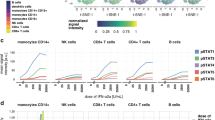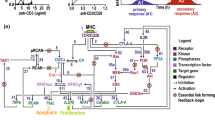Abstract
During an immune response numerous receptor-mediated signals delivered to T cells direct their proliferation, survival and differentiation. Here, we describe a quantitative model and in vitro methods for assessing the “calculus” used by T cells to process these multiple signals. The model reveals how T cells convert independently received signals into linear additive effects on division times which, in turn, amplify T cell number exponentially. These results explain why so many ligands can each appear obligatory for T cell activation and argue for a re-examination of the two-signal theory as the basis for decisions between tolerance and activation.
This is a preview of subscription content, access via your institution
Access options
Subscribe to this journal
Receive 12 print issues and online access
$209.00 per year
only $17.42 per issue
Buy this article
- Purchase on Springer Link
- Instant access to full article PDF
Prices may be subject to local taxes which are calculated during checkout





Similar content being viewed by others
References
Chambers, C. A. & Allison, J. P. Co–stimulation in T cell responses. Curr. Opin. Immunol. 9, 396–404 (1997).
Sperling, A. I. & Bluestone, J. A. The complexities of T–cell co-stimulation: CD28 and beyond. Immunol. Rev. 153, 155–82 ( 1996).
Grewal, I. S. & Flavell, R. A. The role of CD40 ligand in costimulation and T–cell activation. Immunol. Rev. 153, 85–106 (1996).
Janeway, C. A. Jr & Bottomly, K. Signals and signs for lymphocyte responses. Cell 76, 275–85 (1994).
Bachmann, M. F. et al. Distinct roles for LFA–1 and CD28 during activation of naïve T cells: adhesion versus costimulation. Immunity 7, 549–57 ( 1997).
Cantrell, D. A. & Smith, K. A. The interleukin–2 T–cell system: a new cell growth model. Science 224, 1312–1316 (1984).
Smith, K. A. Interleukin–2: inception, impact, and implications. Science 240, 1169–1176 ( 1988).
Mosmann, T. R. & Coffman, R. L. TH1 and TH2 cells: different patterns of lymphokine secretion lead to different functional properties. Annu. Rev. Immunol. 7, 145– 173 (1989).
Swain, S. L., Weinberg, A. D., English, M. & Huston, G. IL–4 directs the development of Th2–like helper effectors. J. Immunol. 145, 3796–3806 (1990).
Seder, R. A. & Paul, W. E. Acquisition of lymphokine–producing phenotype by CD4+ T cells. Annu. Rev. Immunol. 12, 635–73 (1994).
Weiss, A. & Littman, D. R. Signal transduction by lymphocyte antigen receptors. Cell 76, 263– 74 (1994).
Lyons, A. B. & Parish, C. R. Determination of lymphocyte division by flow cytometry. J. Immunol. Methods 171, 131–137 (1994).
Gett, A. V. & Hodgkin, P. D. Cell division regulates the T cell cytokine repertoire, revealing a mechanism underlying immune class regulation . Proc. Natl Acad. Sci. USA 95, 9488– 93 (1998).
Viola, A. & Lanzavecchia, A. T cell activation determined by T cell receptor number and tunable thresholds. Science 273, 104–6 (1996).
Iezzi, G., Karjalainen, K. & Lanzavecchia, A. The duration of antigenic stimulation determines the fate of naïve and effector T cells. Immunity 8 , 89–95 (1998).
Germann, T. et al. Interleukin-12/T cell stimulating factor, a cytokine with multiple effects on T helper type 1 (Th1) but not on Th2 cells. Eur. J. Immunol. 23, 1762–70 (1993).
Estaquier, J. et al. T helper type 1/T helper type 2 cytokines and T cell death: preventive effect of interleukin 12 on activation-induced and CD95 (FAS/APO-1)-mediated apoptosis of CD4+ T cells from human immunodeficiency virus-infected persons. J. Exp. Med. 182, 1759– 67 (1995).
Trinchieri, G. Interleukin-12: a proinflammatory cytokine with immunoregulatory functions that bridge innate resistance and antigen-specific adaptive immunity. Annu. Rev. Immunol. 13, 251–76 (1995).
Brown, M., Hu-Li, J. & Paul, W. E. IL-4/B cell stimulatory factor 1 stimulates T cell growth by an IL-2-independent mechanism. J. Immunol. 141, 504–11 (1988).
Fernandez-Botran, R., Sanders, V. M., Mosmann, T. R. & Vitetta, E. S. Lymphokine-mediated regulation of the proliferative response of clones of T helper 1 and T helper 2 cells. J. Exp. Med. 168, 543–58 (1988).
Pfeiffer, C. et al. Altered peptide ligands can control CD4 T lymphocyte differentiation in vivo. J. Exp. Med. 181, 1569– 1574 (1995).
Mitchell, L. C., Davis, L. S. & Lipsky, P. E. Promotion of human T lymphocyte proliferation by IL-4. J. Immunol. 142, 1548– 1557 (1989).
Kishimoto, H. & Sprent, J. Strong TCR ligation without costimulation causes rapid onset of fas-dependent apoptosis of naïve murine CD4+ T cells. J. Immunol. 163, 1817 –1826 (1999).
Vella, A., Teague, T. K., Ihle, J., Kappler, J. & Marrack, P. Interleukin 4 (IL-4) or IL-7 prevents the death of resting T cells: Stat6 is probably not required for the effect of IL-4. J. Exp. Med. 186, 325–330 (1997).
Lenardo, M. J. Interleukin-2 programs mouse alpha beta T lymphocytes for apoptosis. Nature 353, 858–61 ( 1991).
Russell, J. H., White, C. L., Loh, D. Y. & Meleedy-Rey, P. Receptor-stimulated death pathway is opened by antigen in mature T cells. Proc. Natl Acad. Sci. USA 88, 2151–5 (1991).
Brunner, T. et al. Cell-autonomous Fas (CD95)/Fas-ligand interaction mediates activation-induced apoptosis in T-cell hybridomas. Nature 373, 441–4 (1995).
Dhein, J., Walczak, H., Baumler, C., Debatin, K. M. & Krammer, P. H. Autocrine T-cell suicide mediated by APO-1/(Fas/CD95) . Nature 373, 438–41 (1995).
Boise, L. H. et al. CD28 costimulation can promote T cell survival by enhancing the expression of Bcl-xl. Immunity 3, 87 –98 (1995).
Sperling, A. I. et al. CD28/B7 interactions deliver a unique signal to naïve T cells that regulates cell survival but not early proliferation. J. Immunol. 157, 3909–17 (1996).
Lafferty, K. J. & Cunningham, A. J. A new analysis of allogeneic interactions. Aust. J. Exp. Biol. Med. Sci. 53, 27–42 (1975).
Lafferty, K. J., Prowse, S. J., Simeonovic, C. J. & Warren, H. S. Immunobiology of tissue transplantation: a return to the passenger leukocyte concept. Annu. Rev. Immunol. 1, 143– 73 (1983).
Green, J.M. et al. Absence of B7-dependent responses in CD28-deficient mice. Immunity 1, 501–508 ( 1994).
Shahinian, A. et al. Differential T cell costimulatory requirements in CD28-deficient mice. Science 261, 609– 12 (1993).
Lindstein, T., June, C. H., Ledbetter, J. A., Stella, G. & Thompson, C. B. Regulation of lymphokine messenger RNA stability by a surface-mediated T cell activation pathway. Science 244, 339–43 ( 1989).
Fraser, J. D., Irving, B. A., Crabtree, G. R. & Weiss, A. Regulation of interleukin-2 gene enhancer activity by the T cell accessory molecule CD28. Science 25, 313– 316 (1991).
Seder, R. A., Germain, R. N., Linsley, P. S. & Paul, W. E. CD28-mediated costimulation of interleukin 2 (IL-2) production plays a critical role in T cell priming for IL-4 and interferon γ production. J. Exp. Med. 179, 299–304 (1994).
Bretscher, P. & Cohn, M. A theory of self-nonself discrimination . Science 169, 1042–1049 (1970).
Bretscher, P. A. A two-step, two-signal model for the primary activation of precursor helper T cells. Proc. Natl Acad. Sci. USA 96, 185 –90 (1999).
Mueller, D. L., Jenkins, M. K. & Schwartz, R. H. Clonal expansion versus functional clonal inactivation: a costimulatory signalling pathway determines the outcome of T cell antigen receptor occupancy. Annu. Rev. Immunol. 7, 445–80 (1989).
Schwartz, R. H. Models of T cell anergy: is there a common molecular mechanism? J. Exp. Med. 184, 1–8 ( 1996).
Krummel, M. F. & Allison, J. P. CD28 and CTLA-4 have opposing effects on the response of T cells to stimulation. J. Exp. Med. 182, 459–65 (1995).
Krummel, M. F. & Allison, J. P. CTLA-4 engagement inhibits IL-2 accumulation and cell cycle progression upon activation of resting T cells. J. Exp. Med. 183, 2533– 40 (1996).
Walunas, T. L. et al. CTLA-4 can function as a negative regulator of T cell activation . Immunity 1, 405–13 (1994).
Leo, O., Foo, M., Sachs, D.H., Samelson, L.E. & Bluestone, J.A. Identification of a monoclonal antibody specific for a murine T3 polypeptide. Proc. Natl. Acad. Sci. USA 84, 1374–1378 (1987).
Harding, F. A., McArthur, J., Gross, J. A., Raulet, D. & Allison, J. P. CD28 mediated signalling costimulated murine T cells and prevents induction of anergy in T cell clones. Nature 356, 607–609 ( 1992).
Hasbold, J. et al. Quantitative analysis of lymphocyte differentiation and proliferation in vitro using carboxyfluorescein diacetate succinimidyl ester. Immunol. Cell Biol. 77, 516–522 (1999).
Hodgkin, P. D., Lee, J. H. & Lyons, A. B. B cell differentiation and isotype switching is related to division cycle number. J. Exp. Med. 184, 277–281 (1996).
Acknowledgements
We thank A. Basten, A. Baxter, M. Davenport, B. Fazekas de St Groth and S. Tangye for suggestions on the manuscript, and J. Allison and B. Castle for providing reagents. We also acknowledge the former professor of mathematics at Padua University who taught us how to combine experiment and mathematics to determine the outcome of interacting independent forces. Supported by a postgraduate scholarship from the University of Sydney (to A.G.) and grants from the NHMRC and the Medical Foundation of the University of Sydney.
Author information
Authors and Affiliations
Corresponding author
Rights and permissions
About this article
Cite this article
Gett, A., Hodgkin, P. A cellular calculus for signal integration by T cells. Nat Immunol 1, 239–244 (2000). https://doi.org/10.1038/79782
Received:
Accepted:
Issue Date:
DOI: https://doi.org/10.1038/79782
This article is cited by
-
Counting generations in birth and death processes with competing Erlang and exponential waiting times
Scientific Reports (2022)
-
Low-dose ipilimumab plus nivolumab combined with IL-2 and hyperthermia in cancer patients with advanced disease: exploratory findings of a case series of 131 stage IV cancers – a retrospective study of a single institution
Cancer Immunology, Immunotherapy (2021)
-
Thymic resident NKT cell subsets show differential requirements for CD28 co-stimulation during antigenic activation
Scientific Reports (2020)
-
Cytokine-mediated communication: a quantitative appraisal of immune complexity
Nature Reviews Immunology (2019)
-
Peptide-specific recognition of human cytomegalovirus strains controls adaptive natural killer cells
Nature Immunology (2018)



